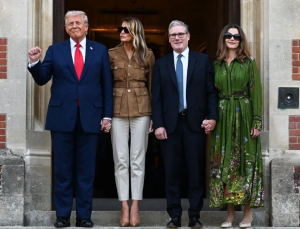
U.S. president Donald Trump urged the UK to use military forces to control migration during a high-profile visit, a statement that goes beyond politics and brushes up against how states use AI surveillance at borders control. This matters because militarized responses can accelerate deployment of AI-enabled sensors, biometrics and analytics — with legal, ethical and societal consequences.
What happened?
- During a state visit, Trump publicly suggested the UK should “call out the military” to stop migration. The remark quickly drew political pushback and media attention. (bbc)
- UK ministers emphasised current border enforcement is managed by civilian agencies and warned that armed forces are normally reserved for external defence and exceptional circumstances.
- The comment sparked debate about the legal and institutional boundaries between civilian border control and military involvement — and about how surveillance technologies would operate if a militarized approach were pursued.
Why this is important
- AI and surveillance scaling: Military involvement can justify rapid scaling of surveillance hardware and analytics (drones, long-range sensors, facial recognition, predictive risk scoring). Once deployed under a security mandate, those systems are harder to limit.
- Rights and accountability: AI-driven systems at militarized borders raise risks of profiling, opaque decision-making, and limited avenues for redress for migrants and citizens alike.
- Market and policy shifts: Defense and surveillance vendors would see expanding markets, and governments could carve out legal exceptions that weaken transparency and oversight frameworks.
Who’s involved
- Political actors: The visiting U.S. politician who made the comments and UK ministers responding on borders and defence. (bbc)
- Private sector: Defence contractors and firms offering surveillance AI, analytics and biometric platforms.
- Civil society and researchers: Human-rights groups, AI governance researchers and independent auditors monitoring bias, privacy, and rule-of-law implications.
- Regulators: Bodies responsible for national security law and AI governance in the UK and internationally.
Expert perspective
“Mixing military logic with routine border management creates a structural risk — it normalises higher-capacity surveillance under looser oversight,” says Dr. Clara Nguyen, an AI governance researcher.
“Vendors will respond to demand quickly; policymakers must decide whether to let that market shape governance,” adds Marcus O’Sullivan, a data ethics consultant.
Wider context – border control AI
- Governments globally are integrating AI into defense and border operations, from autonomous reconnaissance to automated passenger screening. (Law) and rights groups have repeatedly warned about unchecked deployment. (mnesty)
- Existing AI governance efforts often treat “security” uses as special cases — leaving openings that states can exploit unless laws are tightened. (Atlanticcouncil)
Analysis: possible implications- human rights and AI
- Normalization: If politically accepted, military-backed border control could normalize heavy surveillance in non-conflict settings.
- Dual-use market growth: Firms may develop systems marketed both to defense and civilian agencies, blurring oversight.
- Regulatory pressure: The moment could force regulators to clarify “security” exceptions or risk ceding control to procurement-driven practice.
- Civil resistance: Rights groups and courts are likely to challenge any overreach, pushing for transparency and independent audits.
AI in national security
- The comment is political, but it points to a second-order technical risk: legitimising security exceptions that let AI surveillance systems expand without robust oversight.
- The important debates are legal (what powers are permitted), technical (what systems will be used) and ethical (who bears the burden of errors or bias).
Let’s talk!
